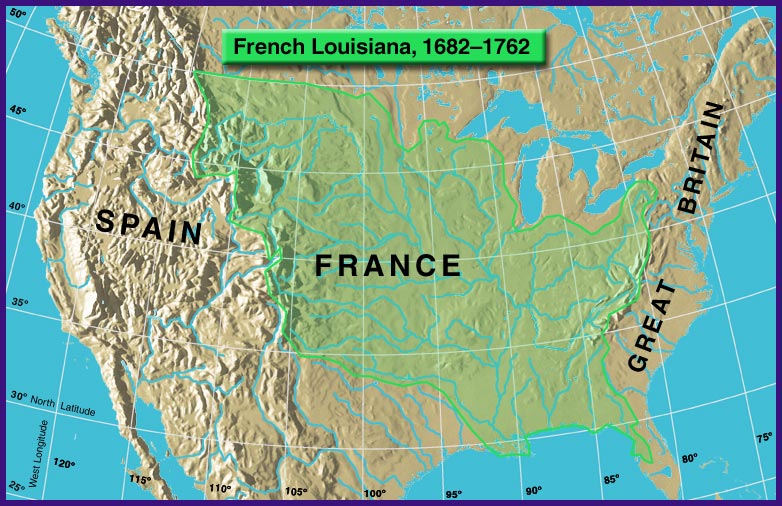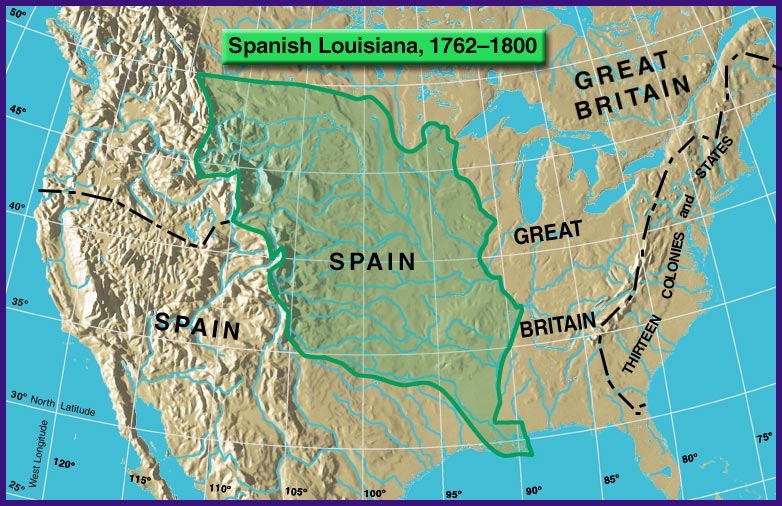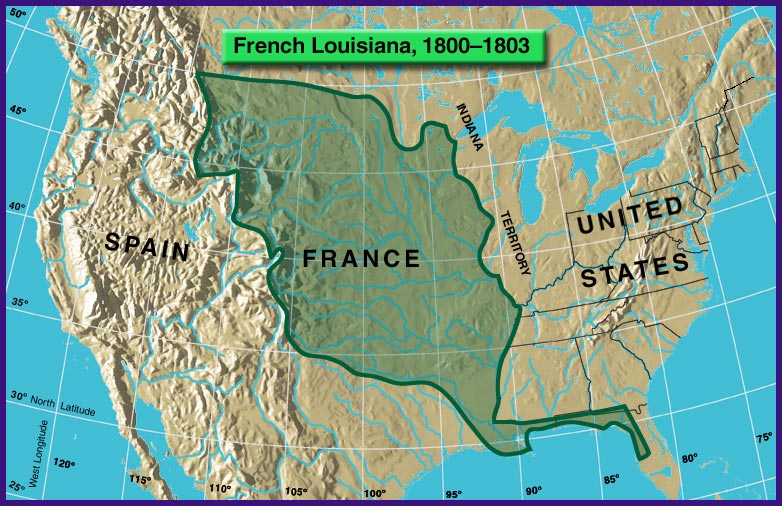French Louisiana, 1682–1762
On 9 April 1682, having explored the Illinois River, and the Mississippi from the mouth of the Illinois to the Gulf of Mexico, in search of a water route across North America, René-Robert Cavalier, Lord of La Salle (1643-1687), claimed,
in the name of His Majesty [Louis XIV (1643-1715)] and of his successors to the crown, possession of this country of Louisiana, the seas, harbors, ports, bays, adjacent straits, and all the nations, people, provinces, cities, towns, villages, mines, minerals, fisheries, streams, and rivers comprised in the extent of said Louisiana, from the mouth of the great river St. Louis on the eastern side, otherwise called Ohio, . . . as also along the river Colbert, or Mississippi, and rivers which discharge themselves therein, from its source, . . . as far as its mouth by the sea, or Gulf of Mexico, about the twenty-seventh degree of the elevation of the North Pole . . . upon the assurance which have received from all [Indian] nations that we are the first Europeans who have descended or ascended the said river Colbert; hereby protesting against all who may in future undertake to invade any or all of these countries, people, or lands, above described, to the prejudice of the rights of His Majesty, acquired by the consent of the nations herein named.
Thus, without any belligerent confrontations, but for lack of clear communication and sympathetic understanding between men, began the decline of one already ancient meta-culture, and the rise of a succession of new empires.
At any rate, La Salle could not possibly have drawn such a map as this, nor would anyone else within the next 200 years. Meanwhile, the geographical and political history of the west was linked with the process of defining boundaries, ownerships, and histories.
Spanish Louisiana, 1762-1800
The Seven Years War, in which England and Prussia triumphed over France, Austria, and Russia, concluded in 1763. That year, the Treaty of Paris gave England control of French Canada as well as Florida.
In the same treaty, France gave Spain all of LaSalle’s claim of 1682, which created a Spanish empire in the Western Hemisphere that extended all the way from the 50th parallel in North America to Cape Horn at the southern tip of South America.
Twenty years later, in 1783, Great Britain gave back to Spain all the territory east of the Mississippi and south of the 31st parallel. Then, in 1800, by the “secret” Treaty of San Ildelfonso, Spain gave all of LaSalle’s Louisiana back to France, including “the Floridas,” which Spain had claimed since 1492.
French Louisiana, 1800-1803
This is roughly the shape of the Louisiana that Jefferson thought he had bought. As large as the portion west of the Mississippi appears, it was the long dog-leg of land east of that line, reaching into the northeast quarter of today’s state of Florida, that was of far greater concern to him, and to the many Americans who had already moved west of the Allegheny Mountains by the end of the 18th Century.
Jefferson found out about Spain’s secret transfer of Louisiana back to France, and in a letter to his good friend, the jurist Robert Livingston, written April 18, 1802, he clearly defined the anxiety the news aroused in him.
There is on the globe one single spot, the possessor of which is our natural and habitual enemy. It is New Orleans, through which the produce of three-eighths of our territory must pass to market, and from its fertility it will ere long yield more than half of our whole produce, and contain more than half of our inhabitants. France, placing herself in that door, assumes to us the attitude of defiance.
The only recourse, he reluctantly confided to Livingston, would be to “marry ourselves to the British fleet and nation.”
He may well have wanted Napoleon to get wind of his concerns, for he neglected to seal the letter, but judiciously offered the French leader a way out:
If France considers Louisiana, however, as indispensable for her views, she might perhaps be willing to look about for arrangements which might reconcile it to our interests. If anything could do this, it would be the ceding to us the island of New Orleans and the Floridas.
It is not known whether Napoleon “got the message” or not.
Meanwhile, Jefferson was not above a little secrecy himself.
American Louisiana, 1803-1819
From the start, Jefferson and his administration, as well as most people who lived along the Gulf Coast, were under the impression that Spain had ceded “the Floridas” to France, along with New Orleans and its sprawling northwestern suburbs. “West Florida” lay south of the 31st parallel between the Perdido River and the Mississippi; “East Florida” extended from the Perdido River along the Gulf Coast to Tampa Bay.
In 1804 Congress authorized the collection of taxes in West Florida, and in 1810 President James Madison simply proclaimed that area to be part of the Louisiana Purchase. By 1817 the tract had been divided between Mississippi and Alabama, temporarily satisfying some Southern settlers’ needs for convenient seaports.
Two years later, after Andrew Jackson and his soldiers captured Pensacola, Spain was easily persuaded to cede the rest of that part of the continent to the United States. And good riddance it was. Rife with renegade whites, vengeful Indians, runaway slaves, testy soldiers in vulnerable forts, and a few passing pirates, it was not a particularly “nice” neighborhood.
Immediately following General Jackson’s John Quincy Adams, Secretary of State under President James Monroe, negotiated the Adams–Onís Treaty, which went into effect two years later. While gaining all the Gulf Coast east of New Orleans, the U.S. was obliged to accept a western boundary with New Spain (Mexico) defined by the Sabine, Red, and Arkansas Rivers to the 42nd parallel, thence straight to the Pacific Ocean. The Adams-On”s Treaty quashed any American claim to Texas as part of the Louisiana Purchase, but at least the United States was now in control of the entire Gulf Coast east of the Mississippi, including Florida, and its southwestern boundary was firm—for the time being. As a bonus, Spain obligingly surrendered to the U.S. whatever claims to Oregon Territory she had accumulated over the years, leaving the U.S. to work things out on its own with the British up there.
And the price of it all? With the U.S. agreeing to assume outstanding Spanish debts to American citizens who had suffered losses under their regime, which amounted to $5 million, it came to about twelve cents an acre, not counting Oregon.
Altogether, the fortunes of “the Floridas” between 1803 and 1819 were so complex, and often so dramatic, that in terms of daily news-bites the rest of the Louisiana story must have read like backpage boilerplate.
There is a brief but colorful footnote to this era in the history of Louisiana that must not be overlooked. In April of 1804, a month before the Lewis and Clark Expedition set out from Camp Dubois to head across the northwestern part of Louisiana, Jefferson set plans in motion for another expedition into a different region. Precisely two years later, in April of 1806 a party of explorers led by Thomas Freeman and Peter Custis set out from Natchez to explore the Red River. Their objective was to “ground-truth” that part of the boundary between Louisiana and Mexico. They were better prepared, better manned, better funded and better equipped than the Corps of Discovery, but on July 30, only 615 miles up the Red, Spanish soldiers forced them to turn back. Before Lewis and Clark arrived back in St. Louis in September, the Freeman-Custis Expedition was finished and forgotten.
Consolidation, 1819-1912
With access to the Gulf of Mexico secured, national attention was immediately drawn back to Louisiana beyond the Mississippi, for the next big national issue had been waiting in the wings. Louisiana was to become the stage on which the first act in the drama that would culminate in the Civil War, would be played out. During the next sixty years the principles were to be defined there, the players aligned, and decisions tested. The prologue had been the Northwest Ordinance of 1787, which, among other things, forever outlawed slavery from the Northwest Territory.
The next scene was set in Missouri, which sought statehood in 1820. The political problem was, how to maintain a balance of Northern and Southern voting power in the Senate. The solution—the “Compromise”—was to admit Missouri as a slave state, but thenceforth to prohibit slavery north of 36 degrees, 30 minutes north, in the lands acquired through the Louisiana Purchase.
Meanwhile, the question of the actual boundaries of Louisiana continued to demand answers. Lewis and Clark weren’t much help. They crossed the Continental Divide, which separates the Missouri River drainage from the Columbia’s, a total of six times, but never even tried to find the latitude or longitude at their crossing points. They made celestial observations at Camp Fortunate, which was about 30 miles east of Lemhi Pass, but their calculations placed them some 25 or 30 miles south of their actual location. Clark’s map of the Northwest, and of the Rockies where they crossed them, was nonetheless remarkably accurate, considering the time and the place, but it was essentially anecdotal by 20th-century standards. It would remain for railroad surveyors after 1850 to produce more precise records of a few points on the western boundary of Louisiana.
In August of 1805, General James Wilkinson, commander of U.S. forces in the Mississippi Valley, had sent Lieutenant Zebulon Pike to find the sources of the Mississippi River. A year later he sent Pike to explore the Southwest as far as the Rio Grande Valley.
Before the Adams-Onis treaty of 1821, some people held that the Rio Grande River certainly was the southwestern boundary, while Spanish authorities contended that the real western boundary of Louisiana was the ninety-third degree of longitude! On the other hand, a French map of 1762 showed Louisiana extending all the way to the Pacific Ocean, encompassing the area later to become Oregon Territory, and in 1821 François Barbé-Marbois published a map of the United States showing a similar boundary from the Rocky Mountains to the Pacific Ocean approximately along the 42nd parallel. The British, of course, disagreed, and ownership of Oregon Territory remained a point of sometimes violent contention between them and the Americans, especially among the fur traders who did business there.
After the American conquest of northern Mexico in 1848, Eastern backers of a southern transcontinental railroad found the best route lay through some land that still belonged to Mexico. James Gadsden, the U.S. minister to Mexico, engineered the deal, acquiring 30,000 square miles of prime agricultural valley for $10 million—a little under 53 cents an acre.[1]Louisiana Territory, without “the Floridas,” had cost the U.S. about three cents per acre in 1803. In 1999, a single, 85,000-acre parcel of ranch land in central Montana sold to a private … Continue reading>
For further reading
The full text of Jefferson’s letter to Livingston will be found in Richard Hofstadter, Great Issues in American History: From the Revolution to the Civil War, 1765-1865 (New York: Vintage, 1958), 220-222.
For a concise summary of the place and period in question, see Charlton W. Tebeau, A History of Florida (Coral Gables: University of Miami Press, 1971), Chapter 8.
Experience the Lewis and Clark Trail
The Lewis and Clark Trail Experience—our sister site at lewisandclark.travel—connects the world to people and places on the Lewis and Clark Trail.
Plan a trip related to Louisiana’s Political Geography:

Notes
| ↑1 | Louisiana Territory, without “the Floridas,” had cost the U.S. about three cents per acre in 1803. In 1999, a single, 85,000-acre parcel of ranch land in central Montana sold to a private party for $23,000,000—about $270 per acre. |
|---|





